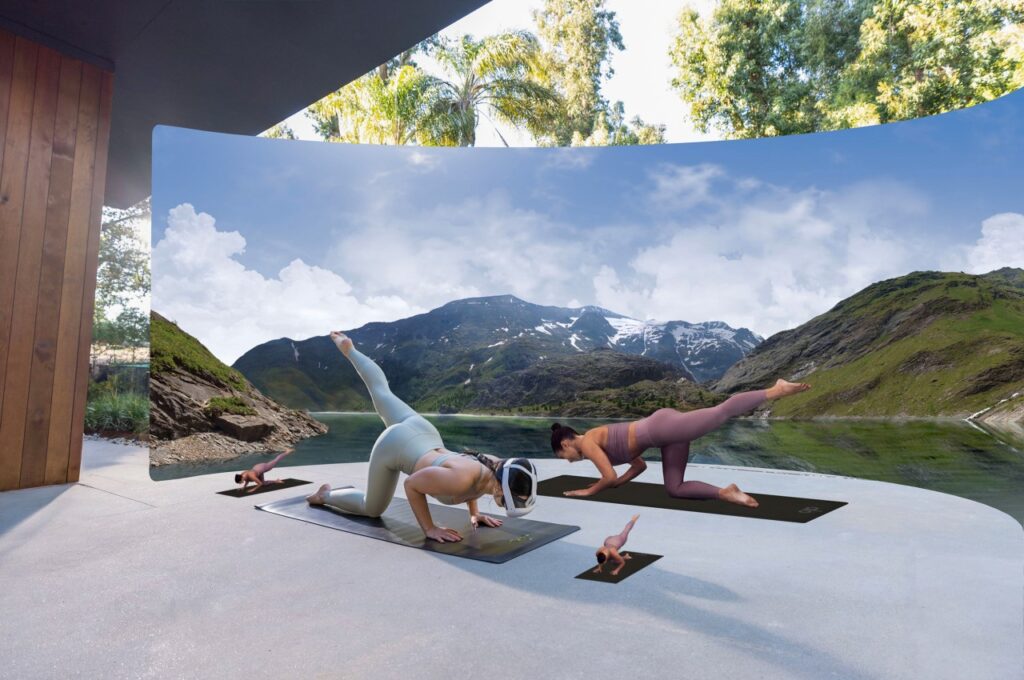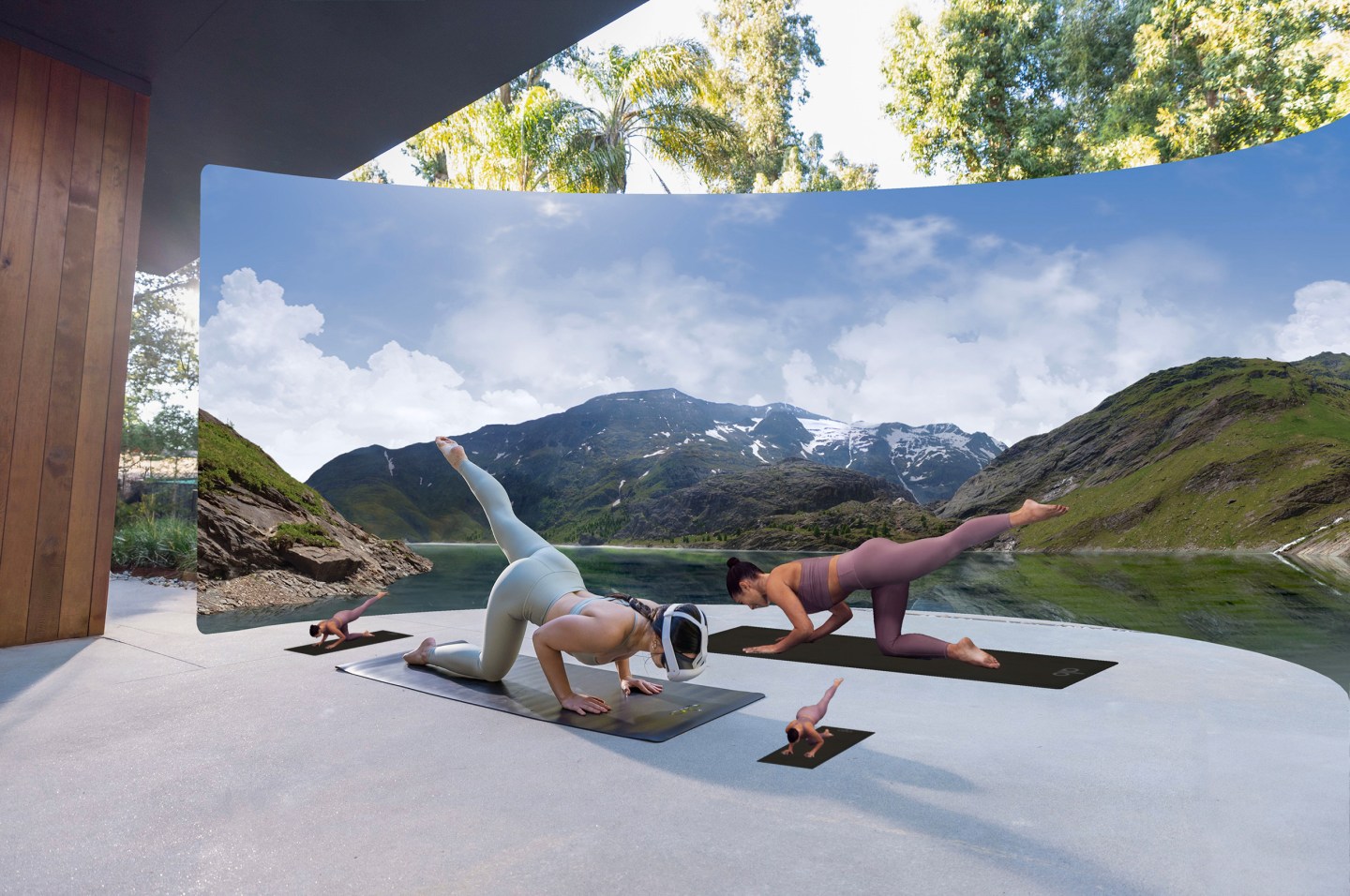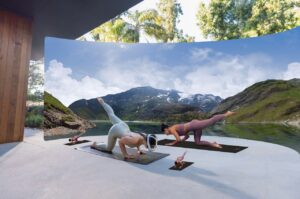I tried virtual reality yoga on Meta’s $500 headset. It was a glimpse into the future of workouts
Alo Moves has introduced mini-instructors which means that you can see a pose from all angles and tweak your own form to match.

Despite their unquestionable convenience, at-home workouts have their limits. You don’t get direct access to the instructor or practice alongside your fellow students. And you definitely don’t get the intangible “vibe” of the third space so many of us crave. By entering the new frontier of virtual reality, companies are trying to create an entirely new way to exercise in your own space, one that doesn’t leave you missing an in-class experience. That, instead, creates an entirely new vision of what at-home movement can look and feel like.
With the launch of its app on the Meta Quest 3, Alo Yoga has made a giant bet on the world of mixed reality—the word for the combination of the physical and virtual worlds that exist inside these headsets. The Alo Moves app delivers virtual instructors straight into your living room so you can complete five to 30-minute classes, including yoga, Pilates, or meditations—that feel more immersive than your typical at-home workout class. Imagine a hologram of your favorite yoga instructor where your coffee table should be, a backdrop of an ocean paradise right behind them. This may sound like something straight out of a science fiction movie, but it’s very real and launched on the VR headset on October 10th.
Eager to explore this virtual yoga studio for myself, I tried a beta of the Alo Moves app. To date, Meta has sold at least one million Meta Quest headsets, but as I unpacked the device (which weighs about 18 ounces), I realized how unprepared I was for mixed reality. The process of learning how to turn on and navigate the virtual world brought to mind the first time I played with the iPhone 1 in 2007. The device felt foreign, vast and new.
Eventually, I hopped on a phone call with Magnopus, the team Alo Moves partnered with to bring their teachers into the meta-sphere. The company is staffed by Oscar-winning visual effects artists working together to “unite the physical and digital world.” The team got to work teaching me how to move through mixed reality, which essentially maps your environment (for example, your living room) before layering the virtual components atop your physical reality.
It took some getting used to, but eventually, I felt comfortable enough in my new habitat to unroll my yoga mat and collect the block, bolsters, and yoga strap I always have on hand. I queued up a yoga class taught by one of the brand’s top teachers, Ashley Galvin. She appeared before me, life-sized and sporting the company’s signature slick athleticwear. Though she didn’t look “real,” she definitely felt more physically present than the 2D version of her I’d grown accustomed to seeing on my computer screen when I practiced with Alo Moves. The ocean roared behind her, virtual waves lapping on the shore.

Alo
Alo Moves and Magnopus have developed these semi-lifelike conditions using volumetric capture, which uses synchronized cameras to capture a 3D view of a landscape or person. “This level of immersion fosters a deeper connection and provides a much clearer understanding of movement, especially for beginners,” said AJ Sciutto, director of future production at Magnopus.
As the 10-minute class began, I couldn’t stop thinking about the weight of the Meta Quest 3. It felt heavy and unnatural on my head, especially in poses where gravity wasn’t my friend—like downward dog and forward fold. The discomfort took me out of the moment, but there were some pros to enduring the strange feeling of the headset.
For one, Alo Moves has introduced mini-instructors, or shrunken-down versions of Galvin that you can place next to your mat and rotate using the hand tracking (a setting that allows you to control your experience with your hands instead of the controllers) on the Meta Quest 3. This means that you can see a pose from all angles and tweak your own form to match, a fantastic feature for beginners and seasoned yogis alike.
I also found that the Meta Quest3 created a barrier between myself and the “real world.” While this definitely felt a little disorienting at first, it had the effect of helping me focus on the yoga class, even though I so often get distracted by dishes, laundry, and work when I work out from home. This feeling that I was both in my space and not added to the pros of this mixed reality experience.
As I removed the Meta Quest3, I kept thinking about how unstoppable mixed reality will be once the headsets are replaced with thin glasses or, better yet, contact lenses. Start-up augmented reality brand Mojo Vision developed a prototype for the latter technology before ceasing to work on it entirely after the company couldn’t drum up more funding. Still, it’s possible that this technology will be in our hands sooner than we think.
As of now, the headset technology feels too bulky to replace my trips to the local studio or good old laptop yoga sessions. Perhaps that will change after Alo Moves launches its full batch of augmented classes later this year. For now, I’m sure that the AR natives who are already used to the extra 18 ounces will love the opportunity to flow in their living room-turned-tropical yoga retreat.
More on workouts:





